The last two posts, July 21 and July 28, covered the impact of the USDA proposed changes on producer payment for their milk. The changes will decrease producer revenue. This post will examine the trends in the prices of the commodities used to price producer milk to see how they might offset the lost revenue. The commodities used for pricing producer milk include cheese, butter, dry whey, and nonfat dry milk (NDM). Cheese prices are analyzed in both Block and Barrel pricing as the USDA proposal includes a change to using only Block cheese to price milk protein. The trends charted cover 2018 to present, and the most recent 31 months. To provide the most current data, the Agricultural Marketing Service (AMS) weekly published prices are used. They are based on the wholesale values of these commodities.
BUTTER PRICES
Charts I and II show the trends in butter prices. Butter prices are the only commodity used to price butterfat. Butterfat is paid in all Classes of milk. This makes increasing butterfat a very high priority for all producers.
The history and trend lines for AMS butter prices in both charts are projecting further increases. Butter has increased in consumption and retail prices. Butter retail purchases are unique due to their cyclical demand which is very high at the end of each year as holiday baking increases.
The trend lines in both charts show current prices to be very close to the trend lines. In 2024 prices have increased steadily and are well above the prior year prices. As 2024 continues to the end of the year when demand is high, it is likely that butter and butterfat prices will continue to increase.
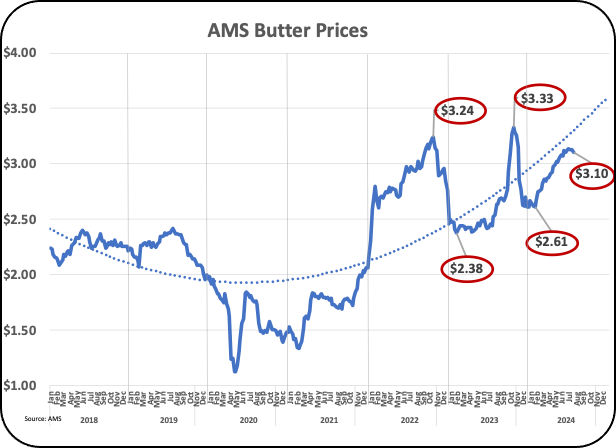

CHEESE PRICES
Cheese prices are reviewed for Block Cheddar cheese and Barrel Cheddar cheese as the new USDA proposal includes a change to use only Block prices instead of an average of Block and Barrel prices. Cheddar cheese prices are used to price milk protein in Class III milk. Cheese prices have increased in the last four months but are still showing declining trends.
Charts III and IV show negative trends for Block Cheddar cheese. Even if this trend reverses in the near future, cheese prices will remain low in 2024. With higher priced butterfat and lower priced cheese, milk protein will continue to be low priced. See this prior post for details on the pricing formula for milk protein.

from 2018 to 2024 YTD
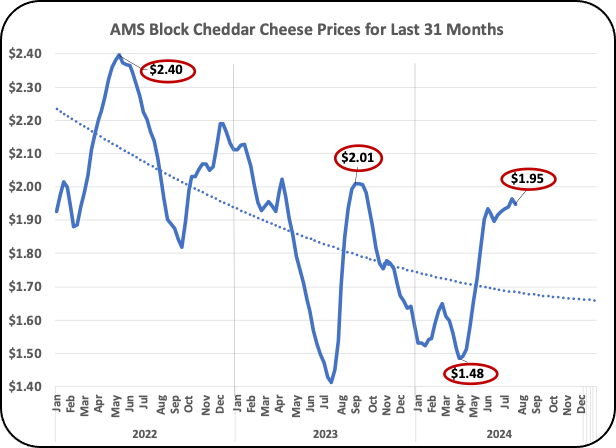
Barrel Cheddar cheese prices (Charts V and VI) are also showing a declining price in the 2018 to 2024 data. Both Block and Barrels are showing the same price in July 2024 but when expressed to four digits, Barrels are slightly higher priced. The shorter trends in Chart VI indicate a slight improvement but the prices will remain low compared to 2022 Cheddar prices. Cheddar prices with both the new Block only pricing or the average Block and Barrel pricing will remain low for at least the remainder of 2024.

from 2018 to 2024 YTD

DRY WHEY
Dry whey prices are used to price “other solids” in the Class III milk. The value is always low and has a small influence in the Class III price. Dry whey has significant exports, with large exports to China to sweeten swine diets as “Whey Permeate” (Whey with protein removed). The longer-term trends in Chart VII indicate a decreasing price while the short-term Chart VIII shows a slight increase. Dry whey prices are well below 2022 prices and will remain low through the remainder of 2024.

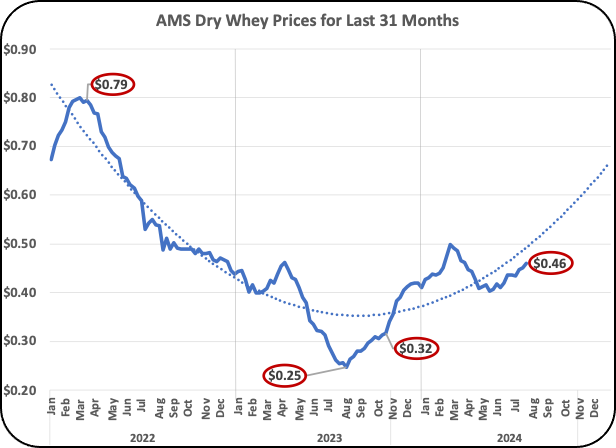
NONFAT DRY MILK
Nonfat dry milk (NDM) is used to price the skim milk in Class IV. NDM is really a by-product of butter churning. Most NDM is exported, and it competes internationally with the much larger category of skim milk powder. The largest U.S. customer is Mexico. The impact of skim Class IV milk expands to Class I. Currently the Class IV skim milk and Class III skim milk is averaged and $.74 is added to calculate the Class I skim price. With the proposed USDA formula changes it would be based on the higher of Class III skim or Class IV skim
NDM prices have fallen significantly from 2022. In 2023 and 2024 the price has stayed around $1.15 per pound (Chart IX and Chart X). Prices will remain in that area for the remainder of 2024.
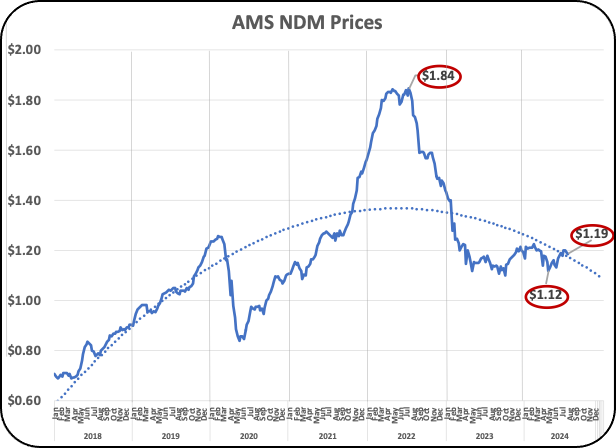
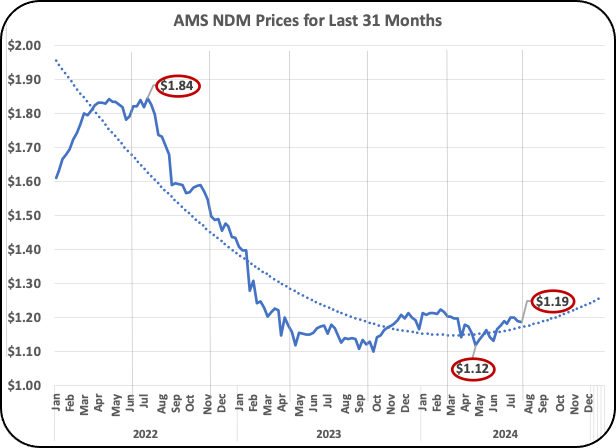
SUMMARY
For at least the remainder of 2024, butterfat prices will remain high, and effort should go into increasing butterfat levels in all milk. All other skim milk prices will remain low. Combined with the proposed USDA formulas, producer prices will continue to be difficult. This will increase the trend of declining small farms. All producers can improve revenue with higher butterfat levels.





One Response
I loved as much as you will receive carried out right here The sketch is tasteful your authored subject matter stylish nonetheless you command get got an edginess over that you wish be delivering the following unwell unquestionably come further formerly again as exactly the same nearly very often inside case you shield this hike